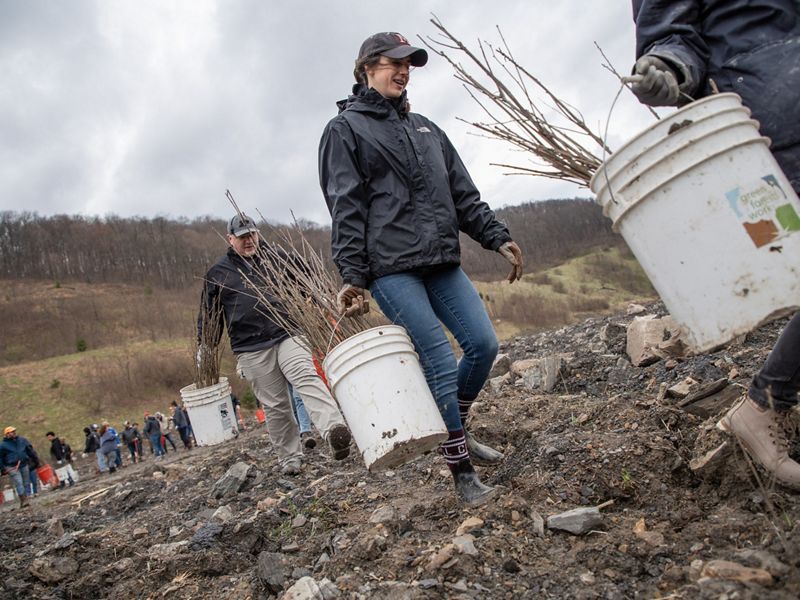
Planting the Future Volunteers from Beam Suntory carry buckets of saplings up a mountain in eastern Kentucky. TNC and its partners have planted hundreds of thousands of trees on former mine lands. © Mike Wilkinson
Kentuckians love their mountains. The Appalachians in the eastern part of the state are a place to admire the beauty of nature, a place to learn about our state’s history and a place to call home. These mountains are also critically important to nature. Many species will use this corridor for migration as the climate warms, including mammals, birds, and amphibians. This region plays an outsized role for carbon storage, too. For freshwater diversity, more rare and imperiled fish, mussels, and crayfish are found in Central and Southern Appalachian rivers than anywhere else in North America.
Reforesting former mine lands
The Nature Conservancy and its partners have hauled hundreds of thousands of trees along rough, remote roads winding into these mountains to reforest former mine lands. On these lands dominated by invasive species and compacted soil, young native forests are coming to life once again. The Nature Conservancy’s reforestation partnership with Green Forests Work has resulted in hundreds of thousands of trees planted. As the Kentucky program continues planting new tracts of land on the Cumberland Forest Ataya property, our goals are to connect healthy forested areas for wildlife migration and create climate-resilient new forests.
Volunteers step up
“We’re working with the TNC science team on our connectivity model, identifying the best places to connect forested habitat on this landscape,” says Chris Garland, Central Appalachians project director for the Kentucky program. “Working with our partners, we’re laying out a roadmap for where our next planting sites will be.”
Beam Suntory has provided both volunteers and funding to plant thousands of trees on the Cumberland Forest Project in Kentucky. While TNC and Green Forests Work plant the majority of the trees on the site, working with professional equipment operators and tree planters, the partners set aside a section of land for these volunteers.
“The job they do is absolutely phenomenal. They don't miss a beat,” Garland says. “There is no quit in them. Even on the second day of these two-day plantings, they are excited and pumped up. And this is hard work—people are sore—but they come back on that second day just as dedicated and eager to get the project done. It’s incredible to see that level of enthusiasm."


Sustainability goals
Kyle Day, senior manager of Forest & Field Sustainability for Beam Suntory, says the Growing for Good and Giving Back to Society initiatives are core values at the company, and everything they do is through the lens of their Proof Positive sustainability strategy,.
“We are proud to help further flagship programs like the reforestation program at the Ataya property in eastern Kentucky and work with our partners The Nature Conservancy and Green Forests Work in support of our ambitions to plant more trees than harvested to make our new barrels and donate one million volunteer hours to our communities by 2030," Days says.


